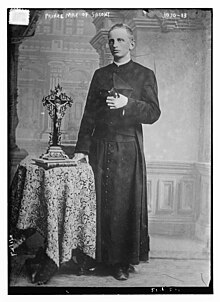Prince Maximilian William Augustus Albert Charles Gregory Odo of Saxony, Duke of Saxony(German:Maximilian Wilhelm August Albert Karl Gregor Odo;17 November 1870 – 12 January 1951) was a member of theAlbertinebranch of theHouse of Wettinand aCatholicpriest.
| Prince Maximilian | |||||
|---|---|---|---|---|---|
 | |||||
| Born | 17 November 1870 Dresden,Kingdom of Saxony,North German Confederation | ||||
| Died | 12 January 1951(aged 80) Fribourg,Canton of Fribourg,Switzerland | ||||
| |||||
| House | Wettin | ||||
| Father | George of Saxony | ||||
| Mother | Infanta Maria Anna of Portugal | ||||
| Religion | Catholicism | ||||
Early life
editThis sectionneeds expansion.You can help byadding to it.(December 2017) |
Maximilian Wilhelm August Albert Karl Gregor Odo of Saxony was born inDresden,capital of theKingdom of Saxony,the seventh of the eight children ofPrince George of Saxonyand his wifeInfanta Maria Anna of Portugal.He was born with the titles Prince and Duke of Saxony, with the styleRoyal Highness.Amongst his siblings was the last Saxon kingFrederick Augustus IIIandPrincess Maria Josephamother of the last Austrian EmperorCharles I.
Priesthood
editOn 26 July 1896, despite initial opposition from his family, Prince Maximilian decided to study for the priesthood and was subsequently ordained aCatholicpriest.[1][2]He renounced his claim to the throne of Saxony on entering the priesthood and also expressed a determination to refuse theapanagethat he was entitled to from the Kingdom of Saxony.[3][4]
Professor
editIn January 1899 Prince Maximilian graduatedDoctor of Theologyfrom theUniversity of Würzburg.[4]After working as apastorat a church inNuremberg,on 21 August 1900 Prince Maximilian accepted the post of Professor ofCanon Lawat theUniversity of Fribourg.[5][6]
In late 1910 Prince Maximilian caused controversy by publishing an article in an ecclesiastical periodical on the union of the Eastern and Roman churches. Prince Maximilian argued that the sixdogmasshould be waived in order to facilitate the return of the Eastern to the Catholic Church.[7]Consequently, upon the article he went to seePope Pius Xto explain, and as a result of the meeting agreed to retract the article and signed a declaration acknowledging errors in it. It was announced that he had renewed his full and unconditional adhesion to the doctrines of the Catholic Church.[8][9]
War
editDuring theFirst World WarPrince Maximilian served as an Army chaplain and in this capacity he attended to wounded soldiers, gaveunctionto the dying and said mass while under shell fire. He was liked by the French prisoners of war as he also dedicated himself to their welfare. He also used the international bureau inGenevato send word to the families of the French prisoners.[10]
Following theGerman Empire's defeat in the war his brother King Frederick Augustus III was forced to abdicate as the monarchy was abolished.
Death
editPrince Maximilian died inFribourg,Switzerland,as the last surviving grandchild ofQueen Maria IIandKing Fernando II of Portugal,and last great-grandchild ofPedro IV of Portugal & I of Brazil.
Honours
edit- Kingdom of Saxony:Knight of theOrder of the Rue Crown[11]
- Kingdom of Prussia:Knight of theOrder of the Black Eagle[11]
- Baden:Knight of theHouse Order of Fidelity,1908[12]
- Kingdom of Bavaria:Knight of theOrder of St. Hubert,1898[13]
- Saxe-Weimar-Eisenach:Grand Cross of theOrder of the White Falcon,1890[14]
- Austria-Hungary:Grand Cross of theOrder of St. Stephen,1891[15]
Ancestry
edit| Ancestors of Prince Maximilian of Saxony (1870–1951) |
|---|
References
edit- ^"A Prince Ordained A Priest".New York Times.1896-07-26. p. 1.
- ^"Knowledge Means Peace".New York Times.1896-07-19. p. 4.
- ^"Prince as Priest in London".The West Australian.1896-10-23. p. 9.
- ^ab"An Unruly German Press".New York Times.1899-01-29. p. 17.
- ^"Object to Prince-Evangelist".New York Times.1900-11-13. p. 5.
- ^"Saxon Prince a Professor".New York Times.1900-08-22. p. 6.
- ^"Pope To Eastern Churches".New York Times.1911-01-03. p. 8.
- ^"Prince Submits to the Pope".New York Times.1910-12-28. p. 5.
- ^"Prince Maximilian Recants".New York Times.1910-12-31. p. 5.
- ^"Peace of the World".New York Times.1915-02-28. p. SM3.
- ^abJustus Perthes,Almanach de Gotha(1923)p. 109
- ^Hof- und Staats-Handbuch des Großherzogtum Baden(1910), "Großherzogliche Orden" p.41
- ^Hof- und Staats-Handbuch des Königreich Bayern(1908), "Königliche Orden" p.9
- ^Staatshandbuch für das Großherzogtum Sachsen / Sachsen-Weimar-Eisenach(1900), "Großherzogliche Hausorden"p. 16
- ^"A Szent István Rend tagjai"Archived22 December 2010 at theWayback Machine